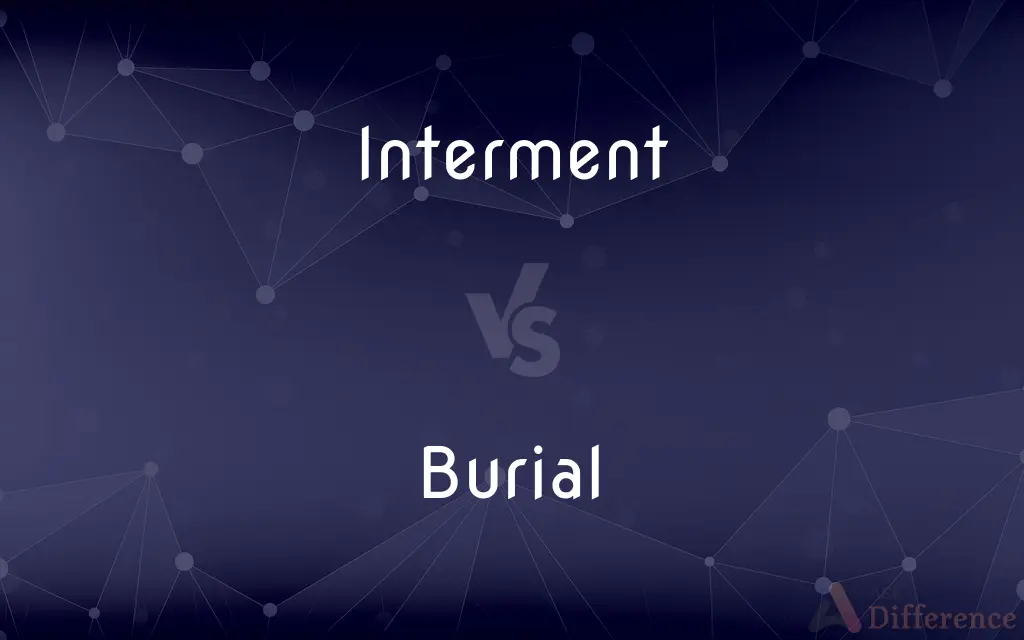Interment vs. Burial — What's the Difference?
Edited by Tayyaba Rehman — By Urooj Arif — Updated on April 6, 2024
Interment is the act of placing remains in a final resting place, often implying a formal or ceremonial process, while burial specifically refers to the act of placing remains in the ground.

Difference Between Interment and Burial
Table of Contents
ADVERTISEMENT
Key Differences
Interment is a broad term that encompasses the act of placing human remains in their final resting place. This can include burial in the ground, entombment in a mausoleum, or placement in a columbarium for ashes. On the other hand, burial specifically refers to the act of placing remains in the ground, either in a coffin or any other type of container.
While burial is one of the most common methods of interment, not all interments are burials. For example, cremation followed by the placement of ashes in a niche is considered interment but not burial. This distinction highlights the variety of ways societies honor the deceased.
Interment is often associated with various rites and ceremonies, reflecting a range of cultural, religious, and personal beliefs about death and the afterlife. Burial, as a form of interment, may also be accompanied by such practices, but the term specifically focuses on the method of disposition rather than the ceremonial aspects.
The choice between different forms of interment, including burial, is influenced by factors such as personal preference, religious beliefs, environmental considerations, and available space. Burial is traditionally preferred in many cultures due to religious or personal beliefs about returning to the earth.
Both interment and burial serve the purpose of providing a dignified and respectful way to handle human remains. They offer closure for the bereaved, allowing them to honor their loved ones in a manner that is meaningful to them.
ADVERTISEMENT
Comparison Chart
Definition
The act of placing remains in a final resting place, which can vary.
Specifically the act of placing remains in the ground.
Scope
Broad, includes burial, entombment, and placement of ashes.
Narrow, limited to in-ground placement.
Ceremonial aspect
Can imply a formal or ceremonial process, not limited to the method of disposition.
Often involves rites and ceremonies but focuses on the disposition method.
Variants
Includes burial, entombment in mausoleums, and ashes in columbaria.
Primarily involves the in-ground placement of a body or ashes.
Cultural and religious considerations
Reflects a range of beliefs about death and the afterlife.
Influenced by traditions and beliefs favoring earth burial.
Compare with Definitions
Interment
A term encompassing various methods of laying the deceased to rest.
The family discussed the best option for interment, considering both burial and cremation.
Burial
May include the use of burial vaults or liners in modern practices.
The cemetery required a burial vault to protect the integrity of the gravesite.
Interment
The act of placing human remains in their final resting place, including burial, entombment, and more.
The interment ceremony was held at the local cemetery, where the family gathered to pay their respects.
Burial
A traditional method of interment favored by many cultures and religions.
Their religion prescribed burial as the only acceptable form of interment.
Interment
Can refer to the placement of ashes in a niche or urn.
After the cremation, the interment of the ashes took place in a serene columbarium.
Burial
Can be part of environmental or "green" practices, depending on the methods used.
They opted for a green burial, with a biodegradable coffin and no embalming chemicals.
Interment
Often implies a process accompanied by rites or ceremonies.
The interment of their loved one was marked by a beautiful service that celebrated their life.
Burial
The act of placing human remains in the ground, typically in a coffin or other container.
The burial took place in the old family plot in the countryside.
Interment
Reflects cultural, religious, and personal beliefs about death and afterlife.
The interment practices of the community were deeply influenced by their spiritual beliefs.
Burial
Reflects a return to the earth, in line with the beliefs of many societies.
They chose burial to honor the belief in being returned to the earth from which they came.
Interment
The burial of a corpse in a grave or tomb, typically with funeral rites
Interments took place in the churchyard
The day of interment
Burial
Concealing something under the ground
Interment
The act or ritual of interring or burying.
Burial
Burial, also known as interment or inhumation, is a method of final disposition whereby a dead body is placed into the ground, sometimes with objects. This is usually accomplished by excavating a pit or trench, placing the deceased and objects in it, and covering it over.
Interment
The act of burying a dead body; burial.
Burial
The action or practice of burying a dead body
His remains were shipped home for burial
Interment
The act or ceremony of depositing a dead body in the earth; burial; sepulture; inhumation.
Burial
The act or process of burying.
Interment
The ritual placing of a corpse in a grave
Burial
The act of burying; interment
His whole family was present at his burial.
His burial rights.
The mourners listened as the priest performed the burial service of long-time parishioner Wendy Stuart.
Burial
A grave; a tomb; a place of sepulture.
The erthe schook, and stoones weren cloven, and biriels weren opened.
Burial
The act of burying; depositing a dead body in the earth, in a tomb or vault, or in the water, usually with attendant ceremonies; sepulture; interment.
Now to glorious burial slowly borne.
Burial
The ritual placing of a corpse in a grave
Common Curiosities
Is burial always part of a religious or ceremonial process?
While often accompanied by religious or ceremonial practices, burial itself is a method of disposition that can be conducted with or without such rites.
Can cremation be considered interment?
Yes, when the ashes are placed in a final resting place, such as a columbarium, it is considered a form of interment.
What is interment?
Interment is the act of placing human remains in their final resting place, which can include burial, entombment, or placement of ashes.
How does burial differ from interment?
Burial specifically refers to the act of placing remains in the ground, whereas interment includes this and other methods of placing remains in a final resting place.
What are the environmental considerations for burial vs. other forms of interment?
Burial, especially green burial, is considered environmentally friendly due to its minimal use of resources and lack of chemicals, unlike traditional burials with embalming and non-biodegradable materials. Other forms of interment, like entombment in mausoleums, have different environmental impacts.
Can interment methods change over time within a culture?
Yes, interment practices can evolve due to changes in societal values, environmental concerns, space availability, and religious beliefs.
What is a columbarium, and how does it relate to interment?
A columbarium is a structure for the storage of urns containing ashes of the deceased. The placement of ashes in a columbarium niche is a form of interment.
What role do cultural beliefs play in the choice between burial and other interment methods?
Cultural beliefs significantly influence the choice, with some cultures preferring burial for its symbolism of returning to the earth, while others may choose cremation or entombment based on beliefs about the afterlife or land use.
How do legal regulations affect interment and burial practices?
Legal regulations can dictate aspects of interment and burial, including the use of vaults, depth of burial, cremation procedures, and the handling and disposition of ashes, varying significantly by region.
Are all burials done in coffins?
Not all burials require coffins. Some cultures and eco-friendly "green" burials use shrouds or biodegradable containers instead of traditional coffins.
How does the choice of interment impact the grieving process?
The choice of interment can significantly impact the grieving process, as it reflects personal and cultural beliefs about death and the afterlife, providing a sense of closure and a way to honor the deceased.
How do modern trends affect interment and burial practices?
Modern trends, including environmental consciousness and space limitations, are leading to increased interest in alternatives to traditional burial, such as cremation, green burials, and innovative methods like bio-urns.
What is a green burial, and how does it compare to traditional burial methods?
Green burial is an eco-friendly alternative that avoids the use of embalming chemicals and non-biodegradable materials, focusing on returning the body to the earth naturally, in contrast to traditional methods that may inhibit decomposition.
Can interment practices vary within the same religion or culture?
Yes, practices can vary widely within a religion or culture due to regional differences, personal preferences, and evolving interpretations of religious texts.
Share Your Discovery

Previous Comparison
Hallway vs. Hall
Next Comparison
Trench vs. DitchAuthor Spotlight
Written by
Urooj ArifUrooj is a skilled content writer at Ask Difference, known for her exceptional ability to simplify complex topics into engaging and informative content. With a passion for research and a flair for clear, concise writing, she consistently delivers articles that resonate with our diverse audience.
Edited by
Tayyaba RehmanTayyaba Rehman is a distinguished writer, currently serving as a primary contributor to askdifference.com. As a researcher in semantics and etymology, Tayyaba's passion for the complexity of languages and their distinctions has found a perfect home on the platform. Tayyaba delves into the intricacies of language, distinguishing between commonly confused words and phrases, thereby providing clarity for readers worldwide.
















































